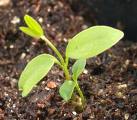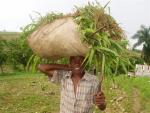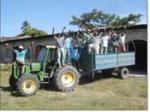Reforestation Has Yet to Take Root in Haiti
 The South Florida Sun Sentinel ran an article concerning the failure of reforestation efforts in Haiti. While little progress has been made to date, there have been small successes. We can learn a great deal by examining the programs which are doing well, asking ourselves why, and then replicating them.
The South Florida Sun Sentinel ran an article concerning the failure of reforestation efforts in Haiti. While little progress has been made to date, there have been small successes. We can learn a great deal by examining the programs which are doing well, asking ourselves why, and then replicating them.
More than Haiti needs another tree nursery or another assessment, it needs a national strategy with buy in from civil society, the Diaspora, and donors. Why is there not a strategy? Instability is the primary reason. While the role of the Government is to set priorities, link them to resources, and to create an environment conducive for civil society to take an active role, instability has prevented this from happening.
 Haitian Political Survival 101 - Preserve power by devoting most of your time, attention, and resource to Port au Prince over the countyside. Previous Administrations have had laws on the books, but they weren't enforced. Though forested areas were designated for preservation, this was never backed up with resources and staffing. Great pains must be taken to protect the preservationists - preserving the environment when you are the only one trying is dangerous business. The charcoal sellers will not take kindly.
Haitian Political Survival 101 - Preserve power by devoting most of your time, attention, and resource to Port au Prince over the countyside. Previous Administrations have had laws on the books, but they weren't enforced. Though forested areas were designated for preservation, this was never backed up with resources and staffing. Great pains must be taken to protect the preservationists - preserving the environment when you are the only one trying is dangerous business. The charcoal sellers will not take kindly.
 With Port au Prince being calmer than it has been in years, and with the current president being an Agronomist, now is the ideal time to launch an aggressive but realistic national campaign. As the article notes, people's highest concern is feeding themeselves and their families If that desire can be linked to preserving the environment, and if people can make a living reforesting, then we will see progress. Would it be expensive? Very likely - but consider the economic costs (for Haiti and the international community) of flooding, hunger, disease, and the sort of instability that comes from not knowing where one's next meal will come from. It would be a wise investment.
With Port au Prince being calmer than it has been in years, and with the current president being an Agronomist, now is the ideal time to launch an aggressive but realistic national campaign. As the article notes, people's highest concern is feeding themeselves and their families If that desire can be linked to preserving the environment, and if people can make a living reforesting, then we will see progress. Would it be expensive? Very likely - but consider the economic costs (for Haiti and the international community) of flooding, hunger, disease, and the sort of instability that comes from not knowing where one's next meal will come from. It would be a wise investment.
If we stick to traditional approaches alone, we lose. Innovation is needed. We advocate for the creation of a Civilian Conservation Corps, a return to the cooperative system of agriculture, scale up of biofuel production, (heavy) subsidization of propane, and national planting days.
 Some groups have used other methods that could be brought to scale. San Diego based Floresta is a religious organization that takes promoting stewardship of the Earth very seriously. They teach innovative agricultural techniques, provide microcredit loans, and are involved in signficant reforestation efforts in Haiti. About 33,000 fruit and hardwood trees a year. This is far smaller than the number of trees cut down each year, but fruit trees are unlikely to be cut. Plus, coffee and other crops can be planted in the shade of fruit trees. If every religious organization (national and international) were involved in reforestation, it would benefit Haiti immensely. The website explains how you can help the organization either by donating, partnering, or volunteering.
Some groups have used other methods that could be brought to scale. San Diego based Floresta is a religious organization that takes promoting stewardship of the Earth very seriously. They teach innovative agricultural techniques, provide microcredit loans, and are involved in signficant reforestation efforts in Haiti. About 33,000 fruit and hardwood trees a year. This is far smaller than the number of trees cut down each year, but fruit trees are unlikely to be cut. Plus, coffee and other crops can be planted in the shade of fruit trees. If every religious organization (national and international) were involved in reforestation, it would benefit Haiti immensely. The website explains how you can help the organization either by donating, partnering, or volunteering.
 The Organization for the Rehabilitation of the Environment (ORE) is a very well known organization based in Camp Perrin in Southern Haiti. If you've not been to this town it has a thriving irrigation system - a lush, green and beautiful place. ORE has produced more than a million fruit trees since it began work in 1985. They make available improved seeds and tree crops including bamboo. Bamboo is very versatile - it is edible, prevents erosion, and can be used for building. The website also has interesting information on rainfall patterns and natural disasters. Through the website, you can donate directly to their programs - five dollars buys a fruit tree, ten dollars seeds an acre, a hunded dollars can produce an orchard.
The Organization for the Rehabilitation of the Environment (ORE) is a very well known organization based in Camp Perrin in Southern Haiti. If you've not been to this town it has a thriving irrigation system - a lush, green and beautiful place. ORE has produced more than a million fruit trees since it began work in 1985. They make available improved seeds and tree crops including bamboo. Bamboo is very versatile - it is edible, prevents erosion, and can be used for building. The website also has interesting information on rainfall patterns and natural disasters. Through the website, you can donate directly to their programs - five dollars buys a fruit tree, ten dollars seeds an acre, a hunded dollars can produce an orchard.
 Why do these two programs succeed where others fail? The fruit can be eaten as well as sold. Smaller organizations also know their communities, are able to build relationships, and as the Sun notes, work with individual farmers. Fruit trees can prevent erosion, produce a crop for internal consumption or international export, and they prevent erosion as well as any other tree. Less erosion means less flooding and mudslides. It will not be possible to blanket the whole country, but this is no excuse to not try.
Why do these two programs succeed where others fail? The fruit can be eaten as well as sold. Smaller organizations also know their communities, are able to build relationships, and as the Sun notes, work with individual farmers. Fruit trees can prevent erosion, produce a crop for internal consumption or international export, and they prevent erosion as well as any other tree. Less erosion means less flooding and mudslides. It will not be possible to blanket the whole country, but this is no excuse to not try.
The damage done to Haiti's environment is severe, and in some parts of the country, will never be the same. However, the right plan with the right level of resources and the right level of engagement by national and international stakeholder could halt and eventually reverse the degradation.
Welcome your thoughts.
Bryan
Add new comment